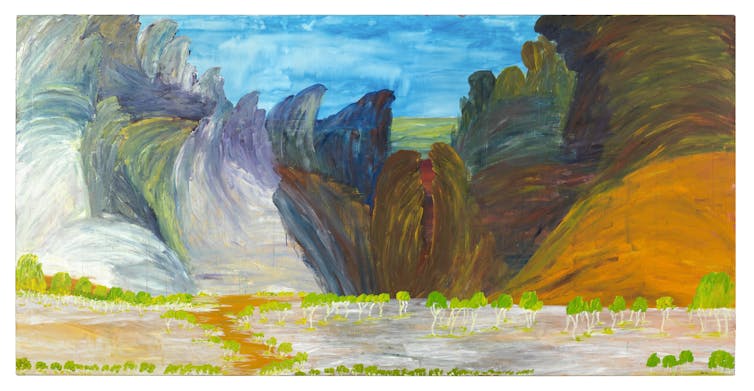crimes, redemption and rebellion – the truths told in 65,000 years of Australian art are essential for national healing
- Written by Joanna Mendelssohn, Honorary Senior Fellow, School of Culture and Communication. Editor in chief, Design and Art of Australia Online, The University of Melbourne

The third section of the Uluru Statement from the Heart is Truth. Without knowing the truth of the history of Australia’s Indigenous people, and how the European invasion continues to impact on them, it is hard to understand the pain behind the loss of The Voice referendum and the ongoing need for treaties.
Marcia Langton and Judith Ryan are truth tellers. Their book 65,000 years: A Short History of Australian Art, should be in every library in the country. The truths they tell are compelling, enticing – sometimes appalling – and unless they are known, the country cannot heal.
Review: 65,000 Years: A Short History of Australian Art, edited by Marcia Langton and Judith Ryan (Thames & Hudson)
For much of the 20th century, there was tension between anthropologists and art curators on the status of what we now call Indigenous art. While anthropologists focused on what they saw as visual evidence for culture and custom, art curators and historians marvelled at what the first history of Australian art, William Moore’s The Story of Australian Art (1934), called a “fine sense of design”. It took many years for all concerned to see that both are true.
A visual embodiment of knowledge
65,000 Years includes essays by anthropologists, art historians, art curators, artists, astronomers and historians. As one of the contributors, astronomer Duane Hamacher writes, “Art is often focused on aesthetics, but more importantly it is a visual embodiment of knowledge.”
The book is focused on the University of Melbourne for two reasons. The first, and most obvious, is that it is published to support an exhibition of the same name, which will open the university’s Ian Potter Museum of Art next year. The second, more potent reason is that this university was both a participant in some of the more shocking crimes against Indigenous Australians and the keeper of works that tell the slow tale of redemption.
As Langton writes, artists “have a special relationship with the world. They can tell the truth where others cannot or will not because they can represent the truth visually.”



















